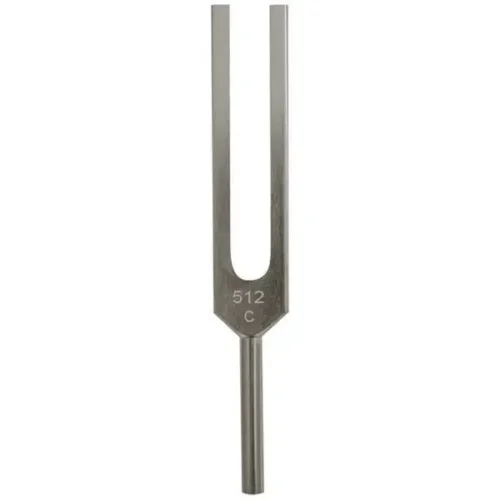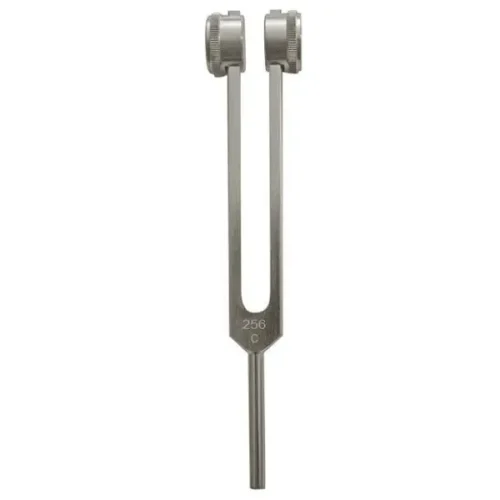A medical turning Fork is basically a medical equipment/ tool just like the stethoscope basically used to assess the degree of hearing and hearing loss through some specialized tests. It is a medical essential offers a quick assessment of hearing and also predicts the type of hearing loss whether conductive or sensorineural and assists the doctor to determine the cause of the hearing loss.
Normally, a healthy individual is expected to perceive the sense of sound through the air by the sound waves propagated from a source and through the bone just behind the ear, the mastoid bone.
However, different medical conditions can result in disrupting this process and cause varying degrees of hearing loss. In order to carry out these tests, the appropriate tuning fork is required to achieve a good assessment. That’s why it’s quite advisable to read this article to the end giving you the insight and authentic information you should know about this instrument.
At the end of this article, you will have a broad view of;
- What a tuning fork is
- The best material for making it
- Tuning fork types, features and uses
- Factors affecting it
- How reliable it is for Rinne and Weber test
- MDF Tuning Fork Reviews
So if you are a medical student or doctor looking for the best tuning forks to buy, this post is for you as I will be reviewing some of the best tuning forks for medical students and doctors; the MDF tuning fork.
What Is A Medical Tuning Fork?
It is a medical instrument that resonates sound when it is struck against a surface. Judging by its name, it looks like a fork.
It comprises a stem also called a handle with two prongs forming a U-shape. The prongs are also called tines. Striking it generates a tone that resonates at a specific pitch which gradually fades out after a while.
It is a simple diagnostic tool for the medical practitioner. It is commonly used to evaluate the different types of hearing loss.
It’s used by a neurologist to assess the function of the nervous system by testing for vibratory sensation.
Tuning Fork Reviews: What You Must Know
The best material is hard little materials, with little international friction to slow down their frictions. The use of aluminum alloy is mostly used but quartz is better- it’s capable of making it vibrate 32,768 times a second.
Tuning Fork Types and Uses
Tuning Forks are of different frequencies ranging from 64Hz to 4096Hz depending on the purpose and test to be used for.
According to research, 128Hz, 256Hz, and 512Hz are the common types frequently used.
The three types will be considered and discussed with each having their it’s different characteristics, purposes, and features.
Nevertheless, the structure is always identical, always with two prongs and a handle.
The 512Hz Type

The 512 Hz frequency type is traditionally preferred because it provides the best balance of time of tone decay and tactile vibration while others provide higher tactile vibration.
The 256Hz Type

At the 256Hz frequency, it is used in hospitals, Pythagorean system, and in Verdi tuning for sound therapy, medical and hearing testing, science class, healing tuning, chakra Le scale, and physics lab and has been standardized since antiquity.
The 128Hz Type

The 128Hz frequency is suitable for alleviation of localized pain. The 128Hz healing tuning fork is used on contractures and arching areas due to its effective healing against contractures and bone and muscle pain.
The 512Hz Tuning Fork vs 256Hz Tuning Fork vs 128Hz Tuning Fork Reviews
| Tuning Forks | 512Hz | 256Hz | 128Hz |
| Physical Property | Smaller and easiest to carry | Easier to handle | Easy to handle |
| Tactile vibration | Lowest | Lower | Low |
| Suitable purposes | Rinne and Weber tests | Weber tests | Healing and dysfunction of the nervous system |
| Detection of conductive hearing loss | Most effective | More effective | Effective |
The 512Hz tuning fork is smaller and easier to carry more advantageous compared to the 256Hz type. It also emits lower tactile vibration compared to 256Hz and 128Hz ones, this makes it more suitable for the testing of hearing loss.
Both the 512 and 256 are used for the weber test. The 128Hz tuning fork is commonly used to assess sensory dysfunction of the nervous system.
The 512Hz tuning fork is preferred for the Rinne tuning fork test because of its sensitivity after it has been compared with other tuning fork results with the pure tune average airborne gap.
It’s very effective at detecting conductive hearing losses when performed by m practitioner and experienced tester. It’s also an important tool in an otology practice for the detection of conductive hearing losses and for confirming audiometric findings.
Medical Tuning Fork Reviews: What Affects It?
The major factor affecting tuning forks is the length of their prongs; the shorter prongs do produce high pitch (frequency) sounds than ones with longer prongs.
Effect Of Using Tuning Forks For Rinne Test
Even though the use of a medical tuning fork for conducting of Rinne test is reliable, there still exist effects of using it.
When hitting it, the prongs/tines is caused to vibrate back and forth hundred times in a second and are so fast that isn’t visible to the human eye mostly. These microscopic collisions can become harmful to the brain.
MDF Tuning Forks: Are they Really the Best?
MDF Tuning fork is one of the products of MDF Instruments which has been crafting medical tools like stethoscopes, tuning forks, sphygmomanometers, and reflex hammers since 1971.
They have been recognized and honored as a result of their style and innovation which leads to the provision of unique and quality products to their customers and different medical organizations including special offers like free stethoscope parts and other medical tools, lifetime warranty on all their products, the validity of returns and cancellations of purchased products and customization of their products.
MDF Instruments is also an official long-term supplier to well-known Non Governmental organizations, World Health Organizations (WHO), and supporters of other lesser medical organizations embarking on the journey of improving lives.
MDF Tuning Forks are made in 128Hz, 256Hz and 512Hz frequencies. They make medical examinations to be performed quickly and perfectly for both my medical personnel and students.
About the MDF Brand of this Instrument
- Material; Aluminum Alloy
- Brand; MDF Instruments
- Manufacturer; MDF Instruments USA
| 512Hz | 256Hz | 128Hz | |
| Item weight | 60 grams | 4 ounces | |
| Package dimensions | 22×4.6×3cm; 60 Grams | 8.74×1.732×1.22 inches | 8.7×1.81×1.41 inches |
| ASIN | B00XIMM8H0 | B00XIMM6F4 | B00XIMM4P4 |
| Customers reviews | 5.0 out of 5 stars | 5.0 out of 5 stars | 4.9 out of 5 stars |
| Bestsellers ranks | 127,076 in business, industry, and science | 36,127 in musical instruments and 273 in musical tuning accessories |
According to customer reviews and ratings, the MDF version of this instrument ranging from 128Hz to 256Hz has been serving its purposes to the buyers both medical personnel and students with only one complaint from the review.
However, when buying an MDF Tuning fork, this should be noted.
- Products are of different outlets and voltages intentionally
- An adapter or converter might be needed before using after purchase
- The compatibility should always be checked before the purchase
Problems with Tuning Forks
The following are the problems liable to surface within the use of this instrument:
- The thick sticky media will leave a coating on the probe which always affects the vibration frequency
- Fouling can always interfere with the resonate frequency which leads to false switch activation
- Turning forks that are protruding into liquid do cause obstruction
- Hygienic cleanliness issues
- High cost
Conclusion
The tuning fork has its own substantial role to play in diagnosis as a medical and diagnostic tool especially when detecting conductive hearing loss and that’s why it’s necessary to be careful and insightful when selecting a tuning fork for any type of diagnosis be it the 128Hz, 256Hz or 512Hz frequencies depending on the severity of deafness and the purpose to be used for without neglecting the effects of using a tuning fork by optimizing it as much as possible.
I hope you find this article interesting and helpful when buying a tuning fork.
Thank you for reading!
Also, Read; Best disposable and Basic Stethoscopes

